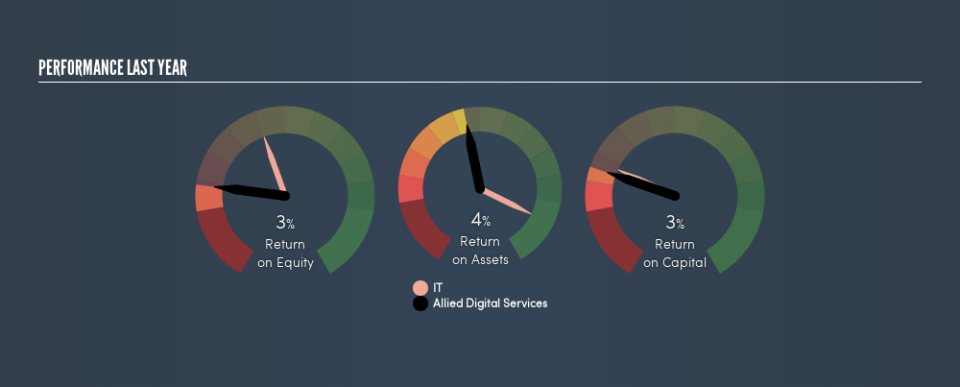Why You Should Care About Allied Digital Services Limited’s (NSE:ADSL) Low Return On Capital

Today we are going to look at Allied Digital Services Limited (NSE:ADSL) to see whether it might be an attractive investment prospect. Specifically, we'll consider its Return On Capital Employed (ROCE), since that will give us an insight into how efficiently the business can generate profits from the capital it requires.
First of all, we'll work out how to calculate ROCE. Second, we'll look at its ROCE compared to similar companies. Then we'll determine how its current liabilities are affecting its ROCE.
Understanding Return On Capital Employed (ROCE)
ROCE measures the amount of pre-tax profits a company can generate from the capital employed in its business. In general, businesses with a higher ROCE are usually better quality. In brief, it is a useful tool, but it is not without drawbacks. Renowned investment researcher Michael Mauboussin has suggested that a high ROCE can indicate that 'one dollar invested in the company generates value of more than one dollar'.
So, How Do We Calculate ROCE?
Analysts use this formula to calculate return on capital employed:
Return on Capital Employed = Earnings Before Interest and Tax (EBIT) ÷ (Total Assets - Current Liabilities)
Or for Allied Digital Services:
0.035 = ₹169m ÷ (₹6.3b - ₹1.5b) (Based on the trailing twelve months to March 2019.)
So, Allied Digital Services has an ROCE of 3.5%.
View our latest analysis for Allied Digital Services
Does Allied Digital Services Have A Good ROCE?
When making comparisons between similar businesses, investors may find ROCE useful. Using our data, Allied Digital Services's ROCE appears to be significantly below the 14% average in the IT industry. This could be seen as a negative, as it suggests some competitors may be employing their capital more efficiently. Independently of how Allied Digital Services compares to its industry, its ROCE in absolute terms is low; especially compared to the ~7.6% available in government bonds. It is likely that there are more attractive prospects out there.
You can click on the image below to see (in greater detail) how Allied Digital Services's past growth compares to other companies.
When considering ROCE, bear in mind that it reflects the past and does not necessarily predict the future. Companies in cyclical industries can be difficult to understand using ROCE, as returns typically look high during boom times, and low during busts. This is because ROCE only looks at one year, instead of considering returns across a whole cycle. If Allied Digital Services is cyclical, it could make sense to check out this free graph of past earnings, revenue and cash flow.
Do Allied Digital Services's Current Liabilities Skew Its ROCE?
Short term (or current) liabilities, are things like supplier invoices, overdrafts, or tax bills that need to be paid within 12 months. The ROCE equation subtracts current liabilities from capital employed, so a company with a lot of current liabilities appears to have less capital employed, and a higher ROCE than otherwise. To check the impact of this, we calculate if a company has high current liabilities relative to its total assets.
Allied Digital Services has total liabilities of ₹1.5b and total assets of ₹6.3b. As a result, its current liabilities are equal to approximately 23% of its total assets. This is not a high level of current liabilities, which would not boost the ROCE by much.
What We Can Learn From Allied Digital Services's ROCE
While that is good to see, Allied Digital Services has a low ROCE and does not look attractive in this analysis. Of course, you might also be able to find a better stock than Allied Digital Services. So you may wish to see this free collection of other companies that have grown earnings strongly.
If you are like me, then you will not want to miss this free list of growing companies that insiders are buying.
We aim to bring you long-term focused research analysis driven by fundamental data. Note that our analysis may not factor in the latest price-sensitive company announcements or qualitative material.
If you spot an error that warrants correction, please contact the editor at editorial-team@simplywallst.com. This article by Simply Wall St is general in nature. It does not constitute a recommendation to buy or sell any stock, and does not take account of your objectives, or your financial situation. Simply Wall St has no position in the stocks mentioned. Thank you for reading.


